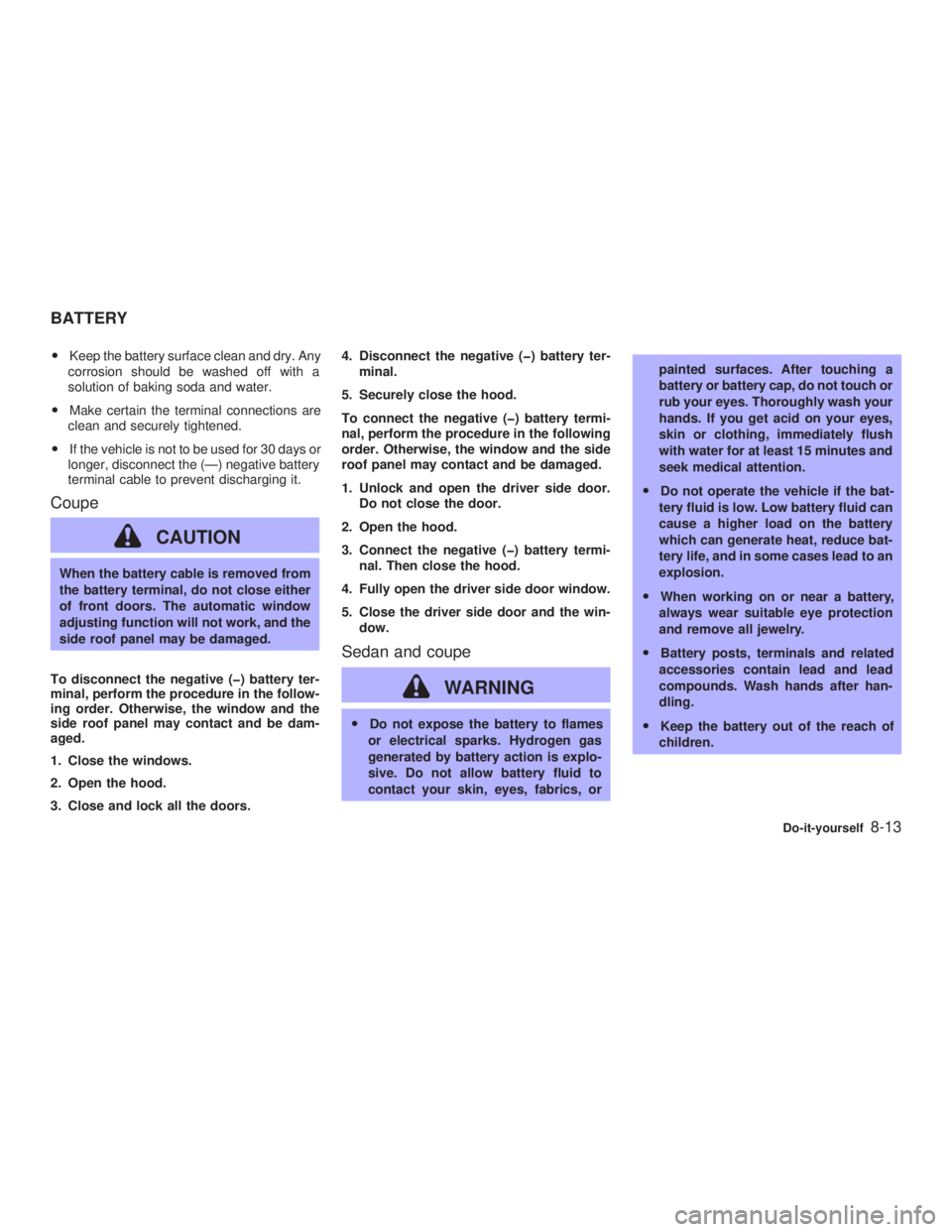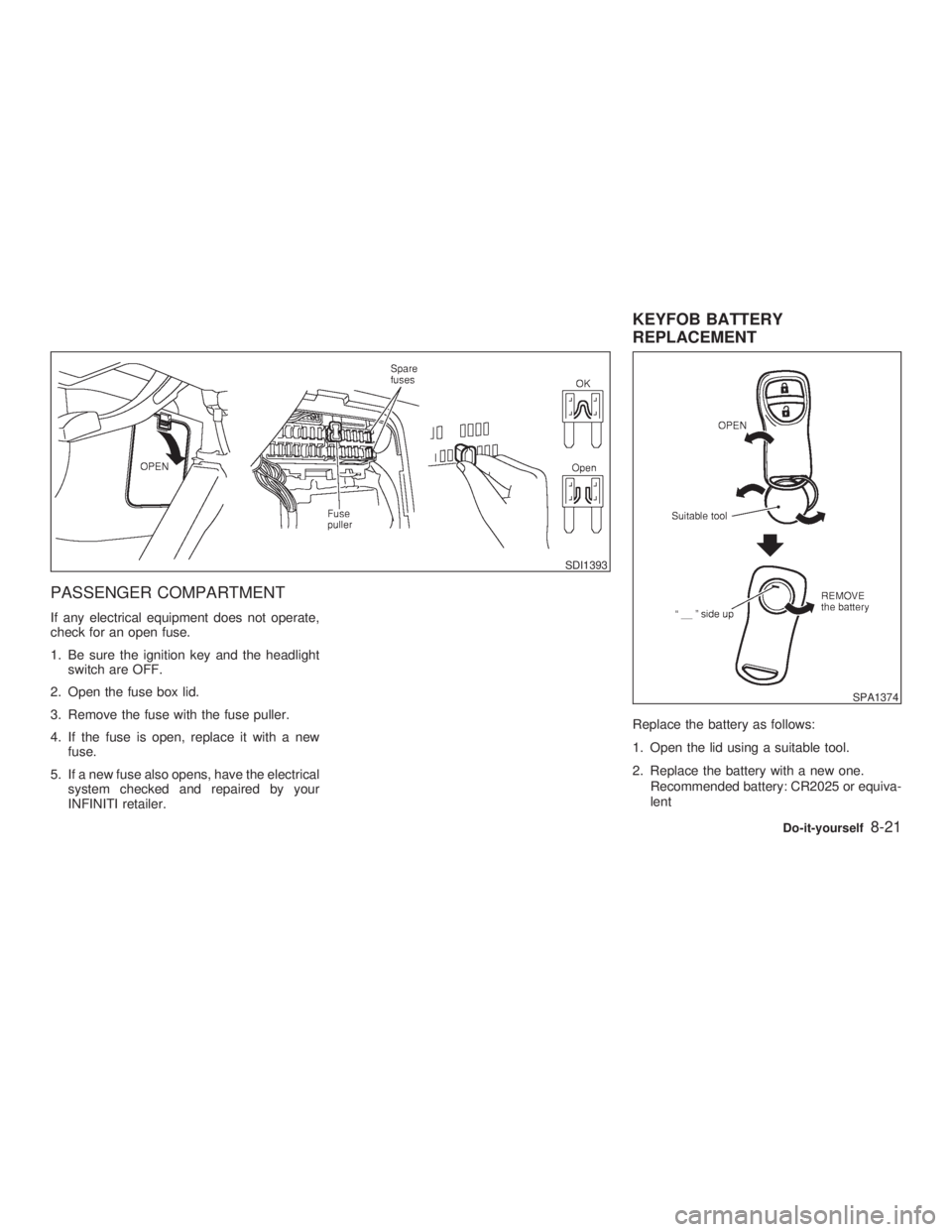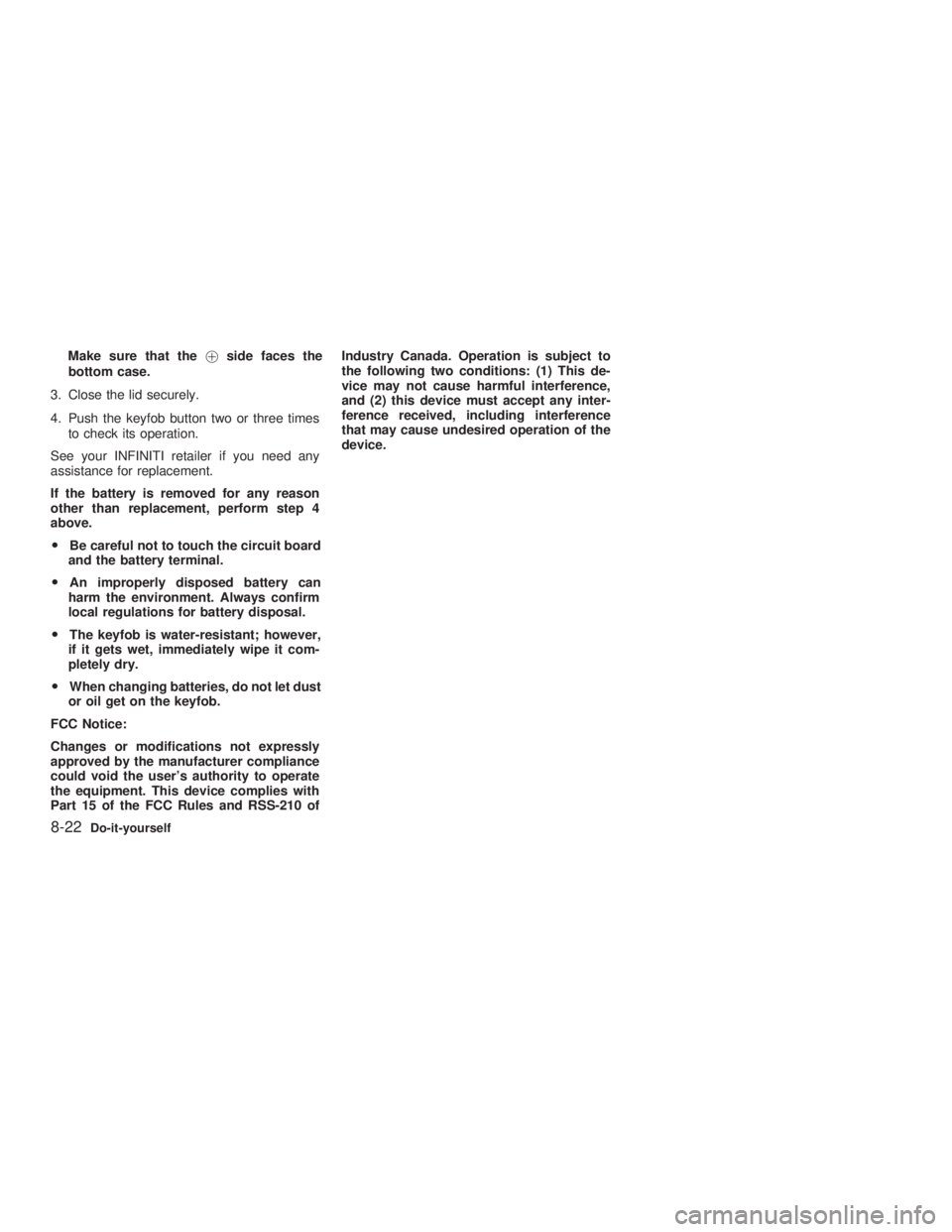2003 INFINITI G35 battery
[x] Cancel search: batteryPage 182 of 256

1. Fuse/fusible link holder
2. Battery
3. Engine oil filler cap
4. Brake fluid reservoir
5. Clutch fluid reservoir
6. Power steering fluid reservoir
7. Engine coolant reservoir
8. Windshield washer fluid reservoir
9. Radiator filler cap
10. Engine oil dipstick
11. Air cleaner
SDI1485ENGINE COMPARTMENT CHECK
LOCATIONS
8-4 Do-it-yourself
Z 02.7.29/V35-D/V5.0
X
Page 191 of 256

O Keep the battery surface clean and dry. Any
corrosion should be washed off with a
solution of baking soda and water.
O Make certain the terminal connections are
clean and securely tightened.
O If the vehicle is not to be used for 30 days or
longer, disconnect the (Ð) negative battery
terminal cable to prevent discharging it.
Coupe
CAUTIONWhen the battery cable is removed from
the battery terminal, do not close either
of front doors. The automatic window
adjusting function will not work, and the
side roof panel may be damaged.
To disconnect the negative (þ) battery ter-
minal, perform the procedure in the follow-
ing order. Otherwise, the window and the
side roof panel may contact and be dam-
aged.
1. Close the windows.
2. Open the hood.
3. Close and lock all the doors. 4. Disconnect the negative (þ) battery ter-
minal.
5. Securely close the hood.
To connect the negative (þ) battery termi-
nal, perform the procedure in the following
order. Otherwise, the window and the side
roof panel may contact and be damaged.
1. Unlock and open the driver side door.
Do not close the door.
2. Open the hood.
3. Connect the negative (þ) battery termi-
nal. Then close the hood.
4. Fully open the driver side door window.
5. Close the driver side door and the win-
dow.
Sedan and coupe
WARNING O Do not expose the battery to flames
or electrical sparks. Hydrogen gas
generated by battery action is explo-
sive. Do not allow battery fluid to
contact your skin, eyes, fabrics, or painted surfaces. After touching a
battery or battery cap, do not touch or
rub your eyes. Thoroughly wash your
hands. If you get acid on your eyes,
skin or clothing, immediately flush
with water for at least 15 minutes and
seek medical attention.
O Do not operate the vehicle if the bat-
tery fluid is low. Low battery fluid can
cause a higher load on the battery
which can generate heat, reduce bat-
tery life, and in some cases lead to an
explosion.
O When working on or near a battery,
always wear suitable eye protection
and remove all jewelry.
O Battery posts, terminals and related
accessories contain lead and lead
compounds. Wash hands after han-
dling.
O Keep the battery out of the reach of
children.BATTERY
Do-it-yourself
8-13
Z 02.7.29/V35-D/V5.0
X
Page 192 of 256

Check the fluid level in each cell. It should be
between the MAX and MIN lines.
If it is necessary to add fluid, add only distilled
water to bring the level to the indicator in each
filler opening. Do not overfill.
Vehicles operated in high temperatures or
under severe conditions require frequent
checks of the battery fluid level.
1. Remove the cell plugs.
2. Add distilled water up to the MAX level.
3. Tighten cell plugs. JUMP STARTING If jump starting is necessary, see ªJump start-
ingº in the ª6. In case of emergencyº section. If
the engine does not start by jump starting, the
battery may have to be replaced. Contact your
INFINITI retailer. 1. Power steering fluid pump
2. Fan
3. Alternator
4. Crankshaft pulley
5. Air conditioner compressor
. : Tension checking points
WARNING Be sure the ignition key is in the OFF or
LOCK position. The engine could rotateDI0137M SDI1480 SDI1389
DRIVE BELTS
8-14 Do-it-yourself
Z 02.7.29/V35-D/V5.0
X
Page 198 of 256

CAUTIONNever use a fuse of higher amperage
rating than that specified on the fuse
box cover. This could damage the elec-
trical system or cause a fire.
ENGINE COMPARTMENT If any electrical equipment does not operate,
check for an open fuse.
1. Be sure the ignition key and headlight
switch are OFF.
2. Open the engine hood and remove the
cover on the battery and the fuse/fusible
link holder.
3. Remove the fuse/fusible link holder cover.
4. Remove the fuse with the fuse puller.
5. If the fuse is open, replace it with a new
fuse. 6. If a new fuse also opens, have the electrical
system checked and repaired by your
INFINITI retailer.
Fusible links If any electrical equipment does not operate
and fuses are in good condition, check the
fusible links. If any of these fusible links are
melted, replace only with genuine NISSAN
parts. SDI1392
FUSES
8-20 Do-it-yourself
Z 02.7.29/V35-D/V5.0
X
Page 199 of 256

PASSENGER COMPARTMENT If any electrical equipment does not operate,
check for an open fuse.
1. Be sure the ignition key and the headlight
switch are OFF.
2. Open the fuse box lid.
3. Remove the fuse with the fuse puller.
4. If the fuse is open, replace it with a new
fuse.
5. If a new fuse also opens, have the electrical
system checked and repaired by your
INFINITI retailer. Replace the battery as follows:
1. Open the lid using a suitable tool.
2. Replace the battery with a new one.
Recommended battery: CR2025 or equiva-
lent SDI1393
SPA1374KEYFOB BATTERY
REPLACEMENT
Do-it-yourself
8-21
Z 02.7.29/V35-D/V5.0
X
Page 200 of 256

Make sure that the ! side faces the
bottom case.
3. Close the lid securely.
4. Push the keyfob button two or three times
to check its operation.
See your INFINITI retailer if you need any
assistance for replacement.
If the battery is removed for any reason
other than replacement, perform step 4
above.
O Be careful not to touch the circuit board
and the battery terminal.
O An improperly disposed battery can
harm the environment. Always confirm
local regulations for battery disposal.
O The keyfob is water-resistant; however,
if it gets wet, immediately wipe it com-
pletely dry.
O When changing batteries, do not let dust
or oil get on the keyfob.
FCC Notice:
Changes or modifications not expressly
approved by the manufacturer compliance
could void the user's authority to operate
the equipment. This device complies with
Part 15 of the FCC Rules and RSS-210 of Industry Canada. Operation is subject to
the following two conditions: (1) This de-
vice may not cause harmful interference,
and (2) this device must accept any inter-
ference received, including interference
that may cause undesired operation of the
device.
8-22 Do-it-yourself
Z 02.7.29/V35-D/V5.0
X
Page 216 of 256

Seat belts: Check that all parts of the seat belt
system (For example, buckles, anchors, ad-
justers and retractors) operate properly and
smoothly, and are installed securely. Check
the belt webbing for cuts, fraying, wear or
damage.
Accelerator pedal: Check the pedal for
smooth operation and make sure the pedal
does not catch or require uneven effort. Keep
the floor mat away from the pedal.
Clutch pedal*: Make sure the pedal operates
smoothly and check that it has the proper free
play.
Brakes: Check that the brakes do not pull the
vehicle to one side when applied.
Brake pedal*: Check the pedal for smooth
operation and make sure it has the proper
distance under it when depressed fully. Check
the brake booster function. Be sure to keep the
floor mat away from the pedal.
Parking brake*: Check that the lever has the
proper travel and confirm that your vehicle is
held securely on a fairly steep hill with only the
parking brake applied.
Automatic transmission P (Park) mecha-
nism: On a fairly steep hill check that your
vehicle is held securely with the selector lever in the P (Park) position without applying any
brakes.
Under the hood and vehicle The maintenance items listed here should be
checked periodically (For example, each time
you check the engine oil or refuel).
Windshield washer fluid*: Check that there
is adequate fluid in the tank.
Engine coolant level*: Check the coolant
level when the engine is cold.
Radiator and hoses: Check the front of the
radiator and clean off any dirt, insects, leaves,
etc., that may have accumulated. Make sure
the hoses have no cracks, deformation, dete-
rioration or loose connections.
Brake and clutch fluid level*: Make sure that
the brake and clutch fluid level is between the
MAX and MIN lines on the reservoir.
Battery*: Check the fluid level in each cell.
It should be between the MAX and MIN lines.
Vehicles operated in high temperatures or
under severe conditions require frequent
checks of the battery fluid level.
Engine drive belts*: Make sure that no belt is
frayed, worn, cracked or oily.
Engine oil level*: Check the level after park- ing the vehicle on a level spot and turning off
the engine. (Wait at least 10 minutes for the oil
to drain back into the oil pan.)
Power steering fluid level* and lines: Check
the level when the fluid is cold and the engine
is turned off. Check the lines for proper attach-
ment, leaks, cracks, etc.
Exhaust system: Make sure there are no
loose supports, cracks or holes. If the sound of
the exhaust seems unusual or there is a smell
of exhaust fumes, immediately locate the
trouble and correct it. See ªPrecautions when
starting and drivingº in the ª5. Starting and
drivingº section for exhaust gas (Carbon mon-
oxide).
Underbody: The underbody is frequently ex-
posed to corrosive substances such as those
used on icy roads or to control dust. It is very
important to remove these substances, other-
wise rust will form on the floor pan, frame, fuel
lines and around the exhaust system. At the
end of winter, the underbody should be thor-
oughly flushed with plain water, being careful
to clean those areas where mud and dirt may
accumulate. For additional information, see
ªCleaning exteriorº in the ª7. Appearance and
careº section.
Fluid leaks: Check under the vehicle for fuel,
oil, water or other fluid leaks after the vehicle
9-4 Maintenance
Z 02.7.29/V35-D/V5.0
X
Page 243 of 256

If you believe that your vehicle has a defect
which could cause a crash or could cause
injury or death, you should immediately
inform the National Highway Traffic Safety
Administration
(NHTSA) in addition to no-
tifying INFINITI.
If
NHTSA receives similar complaints, it
may open an investigation, and if it finds
that a safety defect exists in a group of
vehicles, it may order a recall and remedy
campaign. However,
NHTSA cannot be-
come involved in individual problems be-
tween you, your retailer, or INFINITI.
To contact
NHTSA , you may call the Auto
Safety Hotline toll-free at 1-888-327-4236.
You may also write to:
NHTSA , U.S. De-
partment of Transportation, Washington,
D.C. 20590. You can also obtain other
information about motor vehicle safety from
the Hotline. You may notify INFINITI by contacting our
Consumer Affairs Department, toll-free, at
1-800-662-6200.
In Hawaii call (808) 836-0888. Due to legal requirements in some states/
areas, your vehicle may be required to be in
what is called the ªready conditionº for an
Inspection/Maintenance (I/M) test of the emis-
sion control system.
The vehicle is set to the ªready conditionº
when it is driven through certain driving pat-
terns. Usually, the ªready conditionº can be
obtained by ordinary usage of the vehicle.
If a powertrain system component is repaired
or the battery is disconnected, the vehicle may
be reset to a not ªready conditionº. Before
taking the I/M test, drive the vehicle through
the following pattern to set the vehicle to the
ready condition. If you cannot or do not want to
perform the driving pattern, an INFINITI re-
tailer can conduct it for you.
WARNING Always drive the vehicle in a safe and
prudent manner according to traffic con-
ditions, and obey all traffic laws.
1. Start the engine. Allow the engine to idle
until the engine coolant temperature gauge
needle points between the C and H (normal
operating temperature). 2. Accelerate the vehicle to 55 MPH (88
km/h), then quickly release the accelerator
pedal completely and keep it released for at
least 6 seconds.
3. Quickly depress the accelerator pedal for a
moment, then drive the vehicle at a speed
of 53 to 60 MPH (86 to 96 km/h) for at least
5 minutes.
4. Stop the vehicle. Leave the engine running.
5. Accelerate the vehicle to 35 MPH (55 km/h)
and maintain the speed for 20 seconds.
6. Repeat steps 4 and 5 at least 3 times.
7. Accelerate the vehicle to 55 MPH (88 km/h)
and maintain the speed for at least 3 min-
utes.
8. Stop the vehicle. Place the automatic trans-
mission selector lever in the ªPº or ªNº
position or the manual transmission shift
lever in the ªNº position.
9. Turn the engine off.
10.Repeat steps 1 through 8 at least one more
time.
If step 1 through 7 is interrupted, repeat the
preceding step. Any safe driving mode is ac-
ceptable between steps. Do not stop the en-
gine until step 7 is completed.REPORTING SAFETY DEFECTS
(US only) READINESS FOR INSPECTION/
MAINTENANCE (I/M) TEST (US
only)
Technical and consumer information
10-21
Z 02.7.29/V35-D/V5.0
X